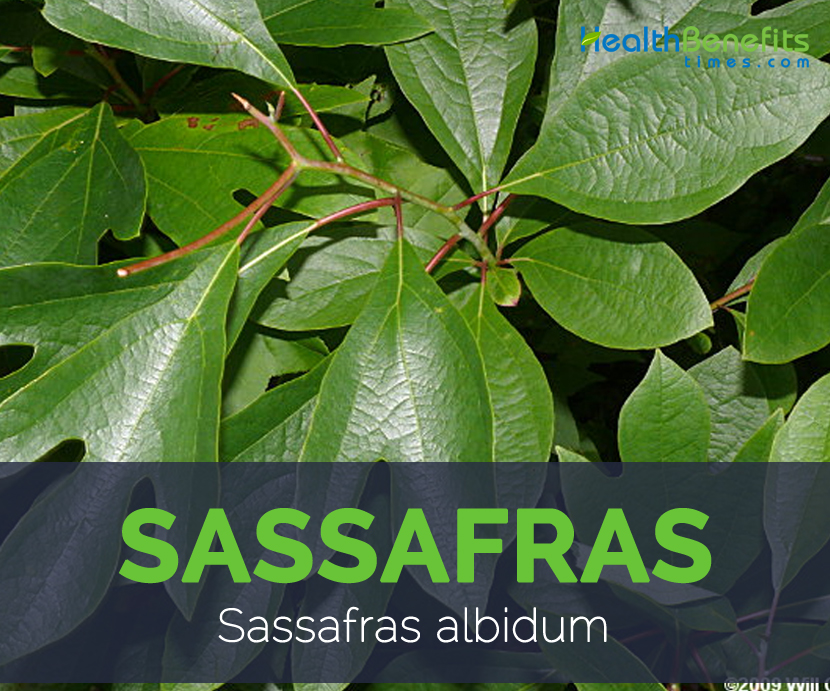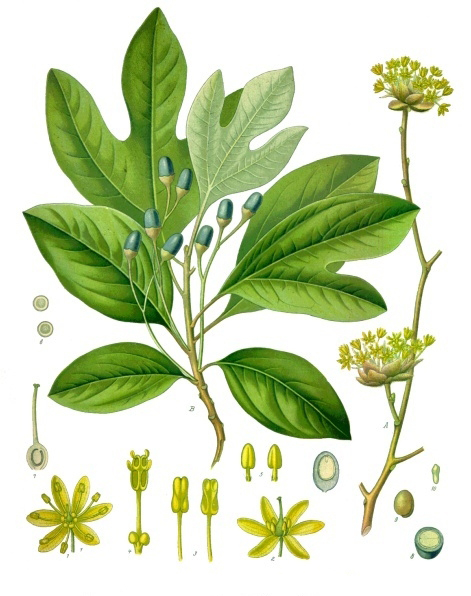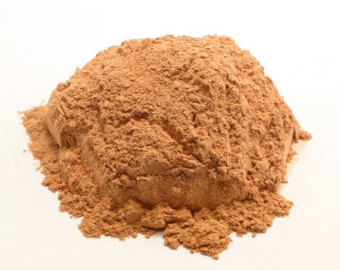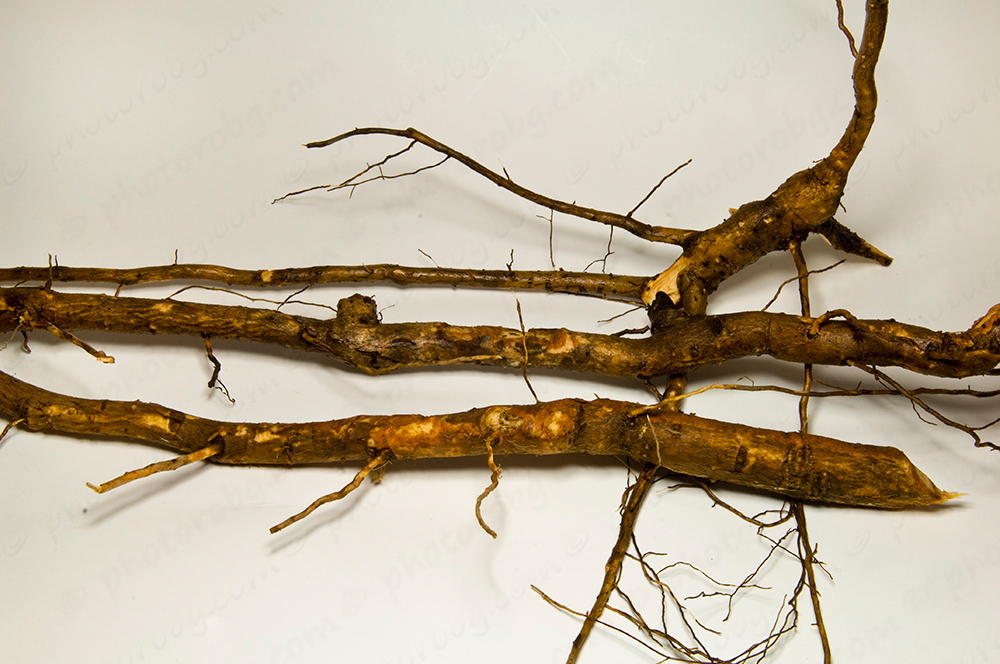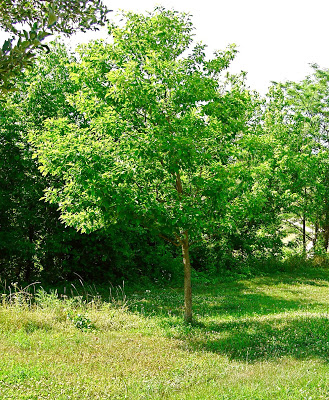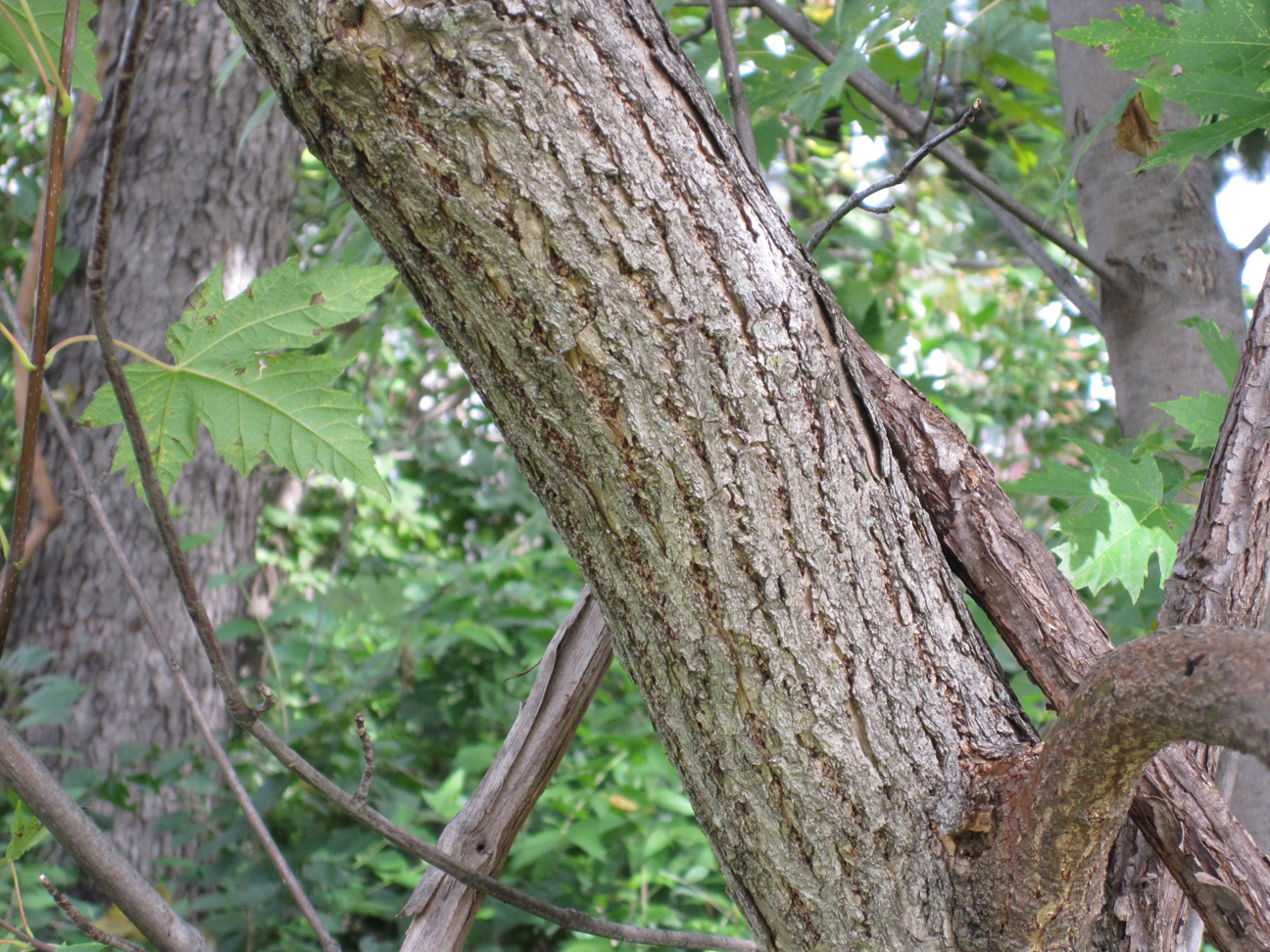A member of the Lauraceae family, the leaves and barks of the tree can be used to obtain essential oil through steam distillation. The root beer that was so popular with early colonists was made using the root of this tree only. The leaves of this tree have a distinct aroma. It is used as a seasoning in various dishes and is also added to thicken soup. Some people dry the root of the tree, and then boil it in water with sugar to form a thick paste, which is used as a condiment.
Plant
Sassafras is a native, perennial, deciduous shrub or tree. The trees are short to medium-tall 9.1 to 18 meters (30-59 feet) tall and spreading 7.6 to 12 meters (25-39 feet) with many slender branches. The root is thick and woody. Young trees have greenish bark. Older trees have reddish brown bark that is rough, thick, and deeply ridged. The leaves are alternate about 7-20 cm long by 5-10 cm broad with variable in shape with either none or one to three lobes at the apex. The two-lobed leaves are mitten shaped. The leaves are light, bright green during the summer and turn to bright yellow-orange and red orange in the fall. The trees are dioecious (a tree will have either male or female flowers) with fragrant flowers. The female flowers (1cm across), borne on small, terminal clusters before the leaves, are without petals, but have six greenish-yellow sepals (3 to 5 mm long). Male flowers are inconspicuous. The female trees have small, oval fruits (6 to 10 mm) that are dark blue with thick, red stalks. The leaf buds appear at the same time the tree flowers in early spring. The fruits ripen in the fall. Almost every part of these trees, including the bark, stems, leaves, branches, roots, fruit, and flowers, for a range of medicinal, culinary, and cultural needs. This tree is packed with impressive nutrients, which is partly why it remained such an important resource.
All parts of the sassafras tree are aromatic with a pleasant odor and a somewhat sweet but astringent taste. The root and root bark were formerly used medicinally. The root is thick and woody. When alive, it is whitish but rapidly turns cinnamon-brown on exposure to air. There are other plants that have the word sassafras in their name that are totally unrelated to Sassafras albidum. These include black sassafras (Oliveri cortex); swamp sassafras (Magnolia glauca); Australian sassafras (Antherosperma moschatum); sassafras goesianum (Massoja aromatica) and California sassafras (Umbellularia californica ).
History
Sassafras was used extensively for food and medicine by Native Americans long before European settlers arrived. Sassafras bark was one of the first exports of the New World. In the southern U.S., the roots were boiled, then combined with molasses, and allowed to ferment into the first ROOT BEER. Today due to its quite beneficial features it is grown throughout the world.
Health benefits of Sassafras
Sassafras has been a key section in culinary, therapeutic, and societal advancement for a large number of years. Which are local to Eastern North America and parts of Asia. These trees are deciduous and can develop more than 100 feet in stature, and have strange yellow or orange bark, making them simple to distinguish. Sassafras has an exceptionally charming taste, which is the reason it is most normally used to season different drugs, yet that is not to lessen from its individual intensity. There are some of the health benefits of Sassafras explain below, let’s have a look.
1. Strengthen Immunity
Modern research has determined that sassafras not only has analgesic properties, but also antiseptic ones, and these natural anti-microbial properties are ideal for boosting the immune system. By protecting the body against foreign agents and pathogens, both internally and externally, this remedy can be a sweet-smelling shield for your overall health. It can also help keep the stomach and respiratory system free from infections, which is why this plant was traditionally suggested to fend off colds at their onset. (1)
2. Prevent Cancer
Although research into this anti-cancer claim is still continuing, sassafras demonstrates measurable antioxidant potential in the human body. Whether it is eliminating free radicals or boosting the immune system, this plant appears to function like many other super foods, lowering your risk of cell mutation and subsequent cancer diagnoses.
3. Sooth Menstrual Pain
For females suffering through the painful symptoms of menstruation, such as bloating, cramping, and heavy bleeding, the analgesic and anti-inflammatory properties of sassafras are a boon. For thousands of years, this natural remedy has decreased the discomfort of menstruation for women, and remains a popular recommendation from herbalists for women who suffer unusually painful periods. (2)
4. Skin Health
Traditionally, sassafras has been used for many different topical issues, and skin health is no exception. If you suffer from boils, sores, rashes, or excessive marks on the skin, applying a poultice of sassafras leaves to the affected areas can rapidly reduce the inflammation or discoloration of the skin. The presence of tannic acid and a unique compound called Sassafrid is thought to provide these benefits and protective measures to the skin. (3)
5. Boost Dental Health
For centuries, sassafras twigs were the early forms of toothbrushes, because of the pleasant flavor (reminiscent of root beer) and the natural antiseptic properties. Using it in this way as a dental disinfectant is still a viable means of getting this benefit, and if you really want to try the traditional approach, grab a twig and give your teeth a scrub.(4)
6. Detoxify the Body
The leaves of sassafras are a well-known diuretic, which increases your urination, therefore eliminating excess toxins, salts, and fats from the body. If you want to improve the health and functioning of your kidneys, the best way is to flush your system with a diuretic, and sassafras tea is a great way to do that. (5)
7. Relieve Pain
The analgesic properties of sassafras are well known, and the leaves of this tree were often wrapped around wounds for their anti-inflammatory and analgesic nature. Sassafras tea is still used for pain-relieving purposes, and topical applications for aches and pains are popular in some natural healing communities. (6)
8. Increase Energy
The stimulant nature of this plant is also great for an energy boost if you’re feeling a bit sluggish. Chewing on the leaves or drinking a cup of sassafras tea is an ideal way to rev up your internal engines and overcome excess fatigue or weakness. (7)
9. Alleviate Inflammation
One of the most popular uses of sassafras is for rheumatism and gout, and this has been a trusted remedy for thousands of years in various parts of the world. Inflammation affects the body in many ways, which means that this impressive plant can also help improve gastrointestinal processes and the symptoms of arthritis, as well as headaches in some cases. Using this plant as a fever reducer is one of the oldest applications of this versatile plant! (8)
10. Malarial Fever and Cold Treatment
The first and foremost property of sassafras revealed out was a productive quality of reducing body temperature caused by any malarial or viral fever. Due to its property to treat ague (any disease that increase body temperature), Sassafras is also known as ague tree. One can have a cup of sassafras tea in the morning to maintain good health in the cold season.
11. Heal Wounds
The pain relief side of wound healing is one thing, but actually speeding up the healing process is quite another. The stimulant nature of this remedy induces freshly oxygenated blood to the sight of the wound, which speeds up the body’s natural healing process and increases the rate of metabolic processes throughout the body. (9)
Sassafras Tea Benefits
1. Toothache Reliever
Analgesic property of sassafras also works in tooth areas and help to reduce the pain caused by any injury or infection occurred in the teeth. The sassafras tea dose can provide the same magical effect to it. Sassafras is also used as an ingredient in many kinds of toothpaste.
2. Scurvy Treatment
Sassafras tea is the best thing one should take to reduce the appearances caused by deficiency of vitamin C. Scurvy causes skin spots, bleeding, yellow skin and fever, which can be treated by regular intake of tea along with other regular medicines.
3. Blood Purification
As discussed above, it helps to extract out impurities from blood to keep it purify. Impure blood is the main essence of many diseases which leads to significant consequences. Cleaning the blood can prevent the diseases and help keep you active and fresh due to healthy hemoglobin content.
4. Rheumatoid Arthritis
Sassafras increases the urine flow through kidney and liver. It also flushes away the uric acids and other impurities from joints and thus gives good relief in gout and rheumatic conditions.
5. Gonorrhea and Syphilis
Sassafras tea can also treat a patient suffering from sexually transmitted diseases as well. Its ability to fight pathogenic bacteria helps us in reducing the severity of the diseases.
6. Herpes Shingles and Measles Treatment
Some of the researches revealed that Sassafras is having antiviral property as well and can deliver relief in herpes, chicken pox and childhood infectious viral disease.
7. Heal Wounds
Because of the ability to relieve pains of the wound, healing wounds is also considered as another of the sassafras tea benefits. To be clear, the stimulant nature of this kind of tea induces blood that has been freshly oxygenated to the sight of wounds thus actually speeding up the body’s healing process and increasing the rate of metabolism throughout the body. As an advice, sassafras tea should be taken by those who suffer from pains and wounds either light or serious.
8. Treat Kidney Ailments
Due to the diuretic properties, the sassafras tea benefits include the ability to cure problems associated with kidneys as well. In fact, it helps clear the urinary tract, decrease irritation, and heal kidney infections. Therefore, you should keep an eye on this kind of cleansing tea when you are possible to suffer from kidney problems or urinary infections indeed and the diuretic tea will help ease the urinary tract irritation and fight kidney ailments.
9. Relieve Adrenal Stress
You may don’t know that adrenal stress can make the symptoms of menopause serious, which is something unexpected for women on the whole. Fortunately, you can deal with this problem by consuming a directed amount of sassafras tea on a regular basis so that it will relieve adrenal stress more efficiently in combination with your medical treatment.
How to Make Sassafras Tea
Let’s read to know how to brew a cup of sassafras tea?
- Take crushed and dried sassafras roots or leaves.
- Brew the roots or leaves of sassafras in water.
- After boiling for around 15 minutes, add sugar for taste. You can also spruce up its taste with few drops of lemon juice.
Sassafras Uses
Sassafras Root
Sassafrases are known for their fragrance and flavor. The root and stems have uniquely different fragrances and flavors. The roots have the smell of root beer since they were one of the primary plants used in making traditional root beer. The stems have a somewhat more citric smell. Safrole is the component in the plant that gives it its unique fragrance and flavor. The roots or stems are boiled to extract the safrole into the liquid, this liquid is then used in small amounts to add flavor to drinks such as tea and root beer. Safrole by itself is very bitter so sweeteners are often used to balance the flavor.
Sassafras Fruit
The Sassafras plant does produce small black sassafras fruit that also may be used as a flavoring but are very bitter and astringent if eaten without diluting them.
Sassafras Leaves
The plant’s leaves have a mucilaginous texture and can be used raw or cooked in salads or eaten right off the plant, unlike the berries, the leaves have a mild pleasant taste.
Sassafras Bark
The bark is different on the trunk vs on the root. Trunk bark has a different flavor then root bark and is used less often. To test this yourself you can scratch and sniff the trunk vs the root bark and you will notice a different fragrance.
How to Eat
- The young leaves can be added to salads.
- Tree and its composite parts have been used in foods ranging from root beer and salads, to sassafras root tea and flavoring agents.
- In Louisiana, the leaves are used as a condiment in sauces, and also for thickening soups.
- Young shoots are used in Virginia for making a kind of beer.
- The leaves, dried and powdered, are the file used in Creole cookery to thicken and flavor soups.
- The dried root bark, steeped to a tea that was served with milk and sugar, made a popular drink called “saloop,”.
- The dried root bark can be boiled with sugar and water until it forms a thick paste. It is then used as a condiment.
Other Traditional uses and benefits of Sassafras
- A cup of sassafras root tea has been a traditional spring tonic in the South for hundreds of years.
- Sassafras tea was considered to be a blood purifier and the essential oil was used in liniments.
- Sassafras combined with prickly ash, cayenne and camphor was made into liniments for rheumatism.
- It was also used by the Cherokee people as a blood thinner to purify blood, to treat skin diseases, rheumatism, among other ailments.
- A cup of sassafras root tea can also relieve adrenal stress, which exacerbates the symptoms in menopause.
- Sassafras tea is able to boost your immune system and fight digestion problems.
- It’s also a good alternative to treat sprains or muscle problems, as it relieves inflammation and eases pain.
- When taken in small amounts, sassafras tea comes as an alternative cancer treatment.
- In Europe, sassafras was used to cure syphilis.
- It can safely be used for eczema and psoriasis it is found to relieve arthritic pain, gout and rheumatism.
- The sassafras oil is said to relieve the pain caused by menstrual obstructions, and pain following parturition, in doses of 5 to 10 drops on sugar, the same dose having been found useful in gleet and gonorrhea.
- Sassafras can be used as a mouthwash to remove infection.
- Sassafras can also be applied on the head to kill lice.
- It is useful to relive intestinal gas.
- A lotion of rose-water or distilled water, with Sassafras Pith, filtered after standing for four hours, is recommended for the eyes.
Other facts
- Sassafras albidum is often grown as an ornamental tree for its unusual leaves and aromatic scent.
- The fragrant oil distilled from the root bark is extensively used in the manufacture of the coarser kinds of perfume, and for scenting the cheapest grades of soap.
- The wood and bark of the tree furnish a yellow dye.
- Sassafras is one of the first plants that will appear in deforested areas.
- Wood of sassafras is used in the manufacture of rails, cabinets, buckets, furniture and as a firewood.
- Sassafras can survive up to 1.000 years in the wild under optimal conditions.
Precautions
- If you are pregnant or breastfeeding you should avoid all forms of this herb. It can promote uterine spasms, heavy bleeding and consequently lead to abortion.
- If you have Kidney problems, heart diseases or high blood pressure then avoid consuming large quantities of sassafras tea as it may interact with heart medication and because it is a blood thinner, it may be fatal even to adults.
- Another important advice about sassafras is to stay away from the small white berries of the sassafras tree, as they may be toxic.
- Sassafras use has caused abortion in several cases.
Sassafras Facts
Aside from being a fun word to say, sassafras has been a key component in the culinary, medicinal development and society for thousands of years. Sassafras trees, scientifically placed in its own genus of Sassafras come in three different existing species. These trees are deciduous and can grow more than 100 feet tall, and have bark unusual yellow or orange, making them easy to identify. In the past, cultures and other Native Americans around the world that had been exported to the trees used almost all parts of these trees, including bark, stems, leaves, branches, roots, fruits and flowers, for a range of medicinal, culinary, and cultural needs. This tree is full of amazing nutrients, which is partly why it was still such an important resource.
| Sassafras Quick Facts | |
|---|---|
| Name: | Sassafras |
| Scientific Name: | Sassafras albidum |
| Origin | Eastern North America and parts of Asia. |
| Colors | Dark-blue or black |
| Shapes | Egg shaped fruit, 1cm long, produced on long red-stalked cups |
| Taste | pleasant taste |
| Health benefits | Strengthen Immunity, Prevent Cancer, Sooth Menstrual Pain, Skin Health, Boost Dental Health, Detoxify the Body, Relieve Pain, Increase Energy, Alleviate Inflammation, Malarial Fever and Cold Treatment, Heal Wounds,Scurvy Treatment, Blood Purification, Rheumatoid Arthritis, Gonorrhea and Syphilis, Herpes Shingles and Measles Treatment, Heal Wounds, Treat Kidney Ailments, Relieve Adrenal Stress |
| Name | Sassafras |
|---|---|
| Scientific Name | Sassafras albidum |
| Native | Native to Eastern North America and parts of Asia. |
| Common Names | Sassafras root , Sassafrass, Saloop, ague tree, root beer tree, saxifras , cinnamon wood, white sassafras, sarifrax or smelling-stick, Bois de Cannelle, Common Sassafras, Kuntze Saloop, Laurier des Iroquois, Laurus albida, Saloip, Sassafras officinale, Sassafras variifolium, Saxifrax |
| Name in Other Languages | Arabic: Sasafras, ساسافراس, سَاسَفْرَاس Croatian: Sasafrasa Czech: Kaštan bělavý, sassafras Dutch: Sassafras, Sassefras English: Augue tree, sassafras Esperanto: Blanketa sasafraso, Sasafraso Estonian: Valkjas sassafras French: Sassafras, German: Fenchelholzbaum, Sassafras Hungarian: Szasszafrász babérfa Italian: Lauro degl’Irocchesi , Sassafrasso Japanese: Sassafurasu, サッサフラス Korean: Sa-sa-pa-reo-seu, sa-sa-peu-reo-seu, Sasapareosu, Sasapureosu, 사사파러스, 사사프러스 Lithuanian: Balkšvasis sassafras Polish: Sasafras lekarski Portuguese: Sassafrás Russian: Lavr amerikanski, Lavr amerikanskij, sassafras, Лавр американский, Сассафрас Slovak: Sassafras, Sassafrasové listy Slovenian: Sasafras Spanish: Sasafrás Swedish: Sassafras Vietnamese: Cay de vang, Cây de vàng |
| Growth Habit | Perennial, deciduous shrub or tree. |
| Growing Climate | Found in the woods, fields and other open areas. |
| Soil | Thrives in deep, rich, neutral-to-acid soil |
| Plan Size | 9.1 to 18 meters (30-59 feet) tall and spreading 7.6 to 12 meters (25-39 feet) |
| Root | Large and woody |
| Bark | Unusual smooth and Spongy yellow or orange bark, Thick and deeply furrowed |
| Leaf | Sassafras has three differently shaped leaves: three-lobed (see above), mitten-shaped and simple (no lobes). leaves are broadly oval, alternate, 7-20 cm long by 5-10 cm broad. Color of the leaves changes to yellow, orange, red and purple before they fall from the tree during the autumn. Crushed leaves release citrus-like scent |
| Flowering Season | May to June |
| Flower | Tiny greenish yellow flowers, with five petals |
| Fruit Shape & Size | Egg shaped fruit, 1cm long, produced on long red-stalked cups |
| Fruit Color | Dark-blue or black |
| Taste | pleasant taste |
| Lifepan | 1.000 years |
| Season | Sep to October |
| Health benefits |
|
References:
https://en.wikipedia.org/wiki/Sassafras
http://www.therighttea.com/sassafras-tea.html
http://www.tipdisease.com/2014/11/benefits-of-sassafras-sassafras-albidum.html
http://eattheplanet.org/sassafras-an-illegal-substance-that-grows-wild-in-our-back-yards/
http://theepicentre.com/spice/sassafras/
http://www.herbs2000.com/herbs/herbs_sassafras.htm
http://www.botanical.com/botanical/mgmh/s/sassaf20.html
http://www.encyclopedia.com/plants-and-animals/plants/plants/sassafras
http://www.softschools.com/facts/plants/sassafras_facts/1283/
https://www.trails.com/list_1268_facts-about-sassafras.html
https://www.drugs.com/npp/sassafras.html
https://www.nps.gov/shen/learn/nature/sassafras.htm
http://davesgarden.com/guides/pf/go/448/
http://www.pfaf.org/user/plant.aspx?LatinName=Sassafras+albidum
https://npgsweb.ars-grin.gov/gringlobal/taxonomydetail.aspx?id=33168
http://www.missouribotanicalgarden.org/PlantFinder/PlantFinderDetails.aspx?kempercode=i820
https://www.mskcc.org/cancer-care/integrative-medicine/herbs/sassafras
https://www.nps.gov/plants/pubs/chesapeake/plant/1240.htm
https://plants.usda.gov/plantguide/pdf/cs_saal5.pdf


